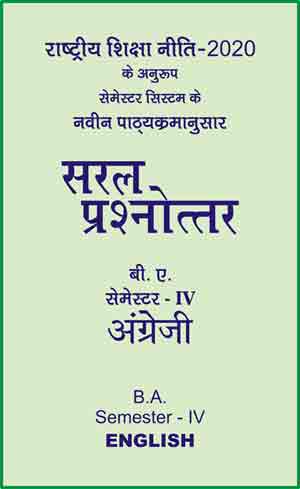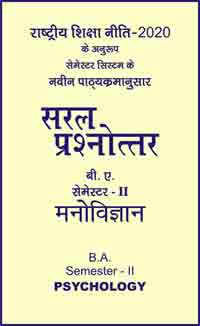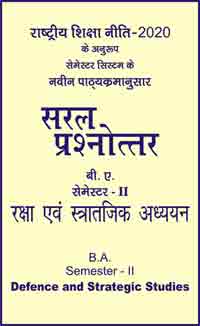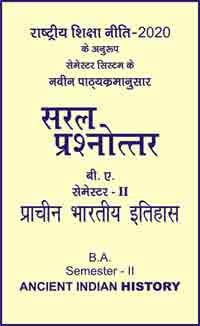|
बी ए - एम ए >> बीए सेमेस्टर-4 अंग्रेजी बीए सेमेस्टर-4 अंग्रेजीसरल प्रश्नोत्तर समूह
|
5 पाठक हैं |
|||||||
बीए सेमेस्टर-4 अंग्रेजी - सरल प्रश्नोत्तर
Unit-VIII
Chapter - 13
Translation Practice
(English to Hindi)
Brief Introduction
Language is fluid. It has evolved through the ages and is still evolving. Most speakers of a language get fluent in a language by speaking it since birth or learning it at a very young age, Nowadays, it is common to teach kids English along with their native language. This way non-native English speakers are fluent in two languages from a young age. This helps in a skill known as translating.
Let's see what translation actually means. the following is the definition of translation:
The rendering of something into another language or into one's own from another language.
In simpler terms, if there's a sentence in English, translation means changing the language of that sentence without changing it's meaning.
We'll understand with an example. Let's take the following translation: English: Today is a beautiful day.
Hindi: आज बहुत सुन्दर दिन है।
Now let's see how it would change the meaning with the following sentence:
Hindi: आज बहुत अच्छा दिन है।
The first Hindi translation conveys exactly what the English sentence meant: today is a beautiful day. However, the second Hindi Translation may seem right but conveys something very different: today is a good day. The difference? The first translation talks about the visual beauty of the day, while the second one says the day feels good. The change may seem small but it makes a huge difference.
English is a language that is used in almost every part of the world. It is instrumental in connecting different parts of the world, which has greatly aided globalization. In most developing countries, English is fast becoming a widely spoken language.
Translation has the following requirements:-
1. Fluency in the original language (here English/Hindi)
2. Fluency in the target language (here English/Hindi)
3. Comprehension skills in both languages
4. Writing skills in both languages
5. Listening skill (for audio-based translation)
So with these 5 requirements, translation is a skill that needs the translator to be excellent in both languages. This means spoken, written, and grammar. Only with these aspects of both languages mastered can someone take up translating.
How to Begin Translating
Of course, just being fluent in both languages may not make a person a good translator. A lot of different things impact translating.
Understanding
It is necessary that you are able to comprehend and understand what you are going to translate. Not being able to understand can lead to faulty and misleading' translations. So make sure to improve your comprehension in both languages.
Context
Context is the situation in which the words are said. This in particular requires a lot of in-depth knowledge of both English and Hindi and their speakers. For example, take the following sentence:
| English | Hindi |
| I cannot believe it! | मुझे विश्वास नहीं हो रहा |
In general, this sentence expresses that the speaker has a hard time believing something has happened, meaning they never expected it. That is the basic meaning of the sentence. Now adding context changes the tone of the sentence completely.
| English | Hindi |
| “I cannot believe it!” she exclaimed joy- ously. | "मुझे विश्वास नहीं हो रहा !” उसने खुशी से कहा। |
| “I cannot believe it!” she said angrily. | "मुझे विश्वास नहीं हो रहा !” उसने गुस्से से कहा। |
The context added here, as you can see, is the emotion of the speaker. Immediately you will notice the difference in the tone of the sentence. The first one is happy disbelief, while the second one is angry disbelief.
Such context adds a lot to a translation and helps the reader understand exactly what was meant. Without context, most sentences may not make sense, especially spoken ones. The only sentences that may not require context even while translating are facts. For example, saying "the sun rises in the east" does not require context to translate.
Awareness
Translation in general requires the translator to be well-read and socially aware of the way in which both languages are currently changing. From formal to informal, the way sentences are structured different. Knowing these differences exist, why they exist, and where they should be applied is a skill every translator should have.
For example, translating an article from English to Hindi require awareness of English phrases, the different ways in which the same word can be used to mean different things, and how you can convey the same meaning in Hindi.
Practice
In the end, all of this will only be effective with practice. With these aspects in mind and the following tips, you will be able to add translation to your skill set in no time.
English to Hindi Translation
Now as you translate, you may feel certain points where you need to improve, or you feel like you can't translate it satisfactorily. So here are 5 ways in which you can improve your translation skills:
1. Read
Read, read and read more. Reading is not just good for vocabulary, comprehension, and learning context, it will also help you find the different ways in which sentences are structured.
Make note of how words and phrases are used, and how ideas are shared in different contexts. Note the tone of the writer and what they are trying to express.
As you read, try and make summaries of the articles or pieces you like. That way you will be able to practice understanding tone, context, ideas, and how to express the same idea differently- all in one go!
Make sure to keep translating as you read. Underline sentences that you find difficult to translate and make notes. Ask about these sentences later from teachers or on online forums. You'll find many that will help you.
2. Write
It is essential to connect the words you read to a medium- whether written or typed. Writing your translations as you translate helps in a number of ways:
Improves your ability to comprehend and translate mentally.
It also improves your ability to express that translation in written form.
Speaking aloud as you write is a great way to check whether what you wrote makes sense or not.
So make it a habit to write as you read and translate.
3. Vice-Versa
It is important, no vital even, to learn how to translate both ways. Sticking to translating, say, English to Hindi will cause you to be out of touch with translating Hindi to English. To make a plan, for every English to Hindi Translation, to a Hindi-to-English one. This way you will get great practice in translating both ways. It will also greatly improve your flow.
4. CAT - Computer-Aided Translation
The internet has a number of tools for translation. The most famous translation tool is Google translate. You can use these to translate sentences or words you aren't sure of. But don't make it a habit to use computer tools! Use these as helpful resources.
5. Converse
Sometimes reading, writing and even the internet may fail in providing you help (though the internet usually succeeds). So also make it a habit to converse with people in the languages that you translate. So talk to people who are good in English in English and the same with people who are great at Hindi.
Conclusion
That brings us to the conclusion. Of course, the biggest way to improve your translation skills is to practice, practice and practice. That is the only way you will be able to know the language better. Both the one you are translating to and translating from. Reading, writing, and talking will always enhance your understanding of language. After all, language is a basic means of communication.
|
|||||














